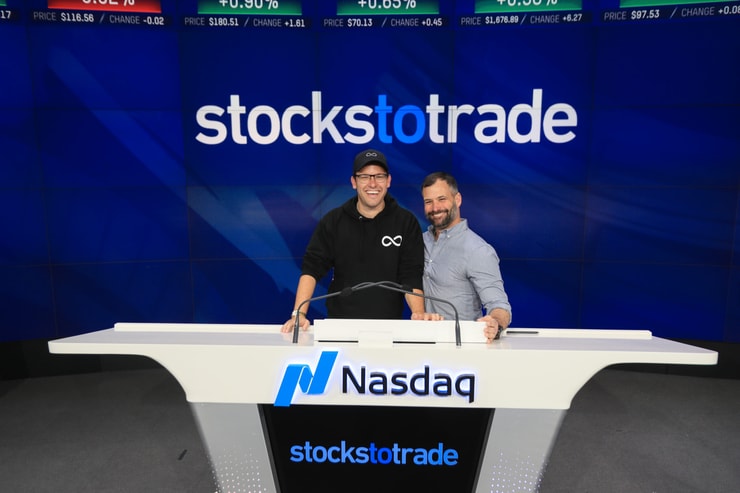Day trading is a financial strategy involving the buying and selling of stocks, currencies, or other securities within the same trading day. Characterized by its fast-paced nature, day traders capitalize on small price movements to generate profits, closing all positions before the market closes to avoid overnight market risk.
This approach contrasts with long-term investment strategies, requiring quick decision-making, constant market analysis, and a thorough understanding of short-term market behaviors. Day trading is popular in stock markets and forex, appealing to traders who seek immediate returns and have a high tolerance for risk.
Readers should dive into this article because it offers a comprehensive understanding of day trading, outlining its history, benefits, risks, and strategies, essential for anyone looking to navigate this fast-paced financial practice.
I’ll answer the following questions:
- What is day trading?
- What is the history of day trading?
- What are the benefits of day trading?
- What are the risks of day trading?
- Should you start day trading?
- What skills do traders need?
- What are general day trading strategies?
- Can you really make money day trading?
Let’s get to the content!
Table of Contents
- 1 What Is Day Trading?
- 2 What Is the History of Day Trading?
- 3 What Are the Benefits of Day Trading?
- 4 What Are the Risks of Day Trading?
- 5 Should You Start Day Trading?
- 6 What Skills Do Traders Need?
- 7 A Guide to Becoming a Day Trader
- 8 What Are General Day Trading Strategies?
- 9 Can You Really Make Money Day-to-Day Trading?
- 10 What Are Some Day Trading Examples?
- 11 Day Trading Guide for Beginners
- 12 How To Set Up a Profitable Daytime Trading Strategy
- 13 Tools and Resources to Starting Day Trading
- 14 What Are the Rules for Day Trading?
- 15 How To Day Trade: A Complete Strategy
- 16 Day Trading Stocks: Important Tips
- 17 Top Day Trading Mistakes To Avoid
- 18 What Are Costs Associated with Day Trading?
- 19 How To Ensure Day Trading Risk Management
- 20 Final Verdict: Is Day Trading Right for You?
- 21 Key Takeaways
- 22 FAQs
What Is Day Trading?
Day trading involves buying and selling securities within the same trading day. Traders capitalize on price movements in the stock market, often leveraging high amounts of capital. Unlike long-term investors, day traders seek profits from short-term price fluctuations. It’s a practice rooted in immediacy, demanding quick decisions and constant market analysis.
With my extensive experience in trading, I’ve seen firsthand how day trading requires a deep understanding of market trends and the ability to react swiftly to market changes.
What Is the History of Day Trading?
The concept of day trading gained momentum with the advent of electronic trading and the internet. Historically, stock trading was the domain of professional brokers and financial institutions.
With the emergence of online trading platforms in the late 20th century, it became accessible to the general public. This democratization of the financial markets led to a surge in day trading, especially during market booms. Over my 20 years in the trading world, I’ve witnessed the evolution of day trading from a niche activity to a widespread financial practice.
What Are the Benefits of Day Trading?
Day trading, the practice of buying and selling financial instruments within the same trading day, offers several advantages. Firstly, it capitalizes on short-term price movements, allowing traders to profit from the volatility in markets. Unlike traditional investing, day trading doesn’t require a significant cash outlay, making it accessible for many people. The use of margin in trading also amplifies potential gains. Additionally, day trading offers flexibility and the opportunity for a living through trading, provided one develops the necessary skills and knowledge.
Potential for Quick Profits
Day trading can offer quick returns due to the short holding period of securities. This rapid turnover can lead to significant profits, especially in volatile markets.
Flexibility and Freedom
One significant advantage of day trading is the flexibility it offers. Traders can work from anywhere with an internet connection, making it a viable option for those seeking a non-traditional work environment.
High Liquidity and Volatility
Day trading thrives on market volatility. High liquidity in the markets facilitates easier entry and exit at desired prices.
Access to Leverage
Traders often use leverage, borrowing capital to increase potential returns. However, this also amplifies risks, which requires careful management.
Diverse Trading Opportunities
The market offers various securities, from stocks to futures, providing day traders with a range of options to diversify their trading strategies.
Ability to Profit in Any Market Direction
Day trading isn’t limited to bullish markets; traders can also profit from falling prices through strategies like short selling.
What Are the Risks of Day Trading?
However, day trading isn’t without risks. The very leverage that offers high returns can also lead to substantial losses, sometimes exceeding the initial investment. The market’s volatility, while a source of profit, can also be unpredictable, leading to potential losses. Day traders must be aware that not all trades will be profitable, and managing these risks is crucial. Additionally, day trading requires a significant time investment for researching and monitoring positions, which can be a drawback for some.
High Financial Risk
Day trading involves substantial financial risk. The use of leverage can lead to large losses, sometimes exceeding the initial investment.
Market Volatility
While volatility can be beneficial, it also increases the risk of substantial losses, especially for inexperienced traders.
Psychological Stress
Day trading demands constant attention and quick decision-making, which can be psychologically taxing.
Overleveraging Danger
Overuse of leverage can lead to significant losses, a risk often underestimated by new traders.
Disclaimer: Day trading carries a higher risk compared to long-term strategies like mutual fund investing or algorithmic trading. It requires a different skill set and a higher tolerance for risk.
Should You Start Day Trading?

Deciding to start day trading is a significant decision. It’s not suitable for everyone, as it requires a specific mindset and skill set. Successful day traders are often those who can handle stress, make quick decisions, and absorb the occasional loss without it affecting their overall strategy.
My years of experience have taught me that day trading requires discipline, a well-thought-out strategy, and continuous learning. If you’re considering day trading, assess your ability to handle risks and dedicate time to learning and trading.
Define your objective for day trading
Understand why you want to day trade: Is it for extra income, a full-time career, or just for the excitement?
Define your financial goal for day trading
Set clear, achievable financial targets. This helps in creating a focused trading strategy.
Define your risk appetite
Knowing your tolerance for risk is crucial in day trading. It dictates the strategies you should adopt and how you manage your trades.
What’s the minimum amount you need to start day trading?
The amount varies based on the market and the broker, but it’s essential to start with an amount you can afford to lose.
What Skills Do Traders Need?
Traders need patience to wait for the right trade opportunities. Analytical skills are crucial for interpreting market data. Research skills help in understanding market trends and news. Focus is needed to monitor markets and make quick decisions. Emotional control is vital to avoid impulsive trading. Documentation, like maintaining a trading journal, is important for tracking progress and learning from past trades.
Mastering the lingo is as crucial as developing analytical skills. Familiarity with day trading terms lays the groundwork for effective communication and understanding of complex trading strategies. Whether it’s ‘bull’ and ‘bear’ markets, ‘short selling’, or ‘leverage’, each term carries significant weight in the reasons behind decisions. For newcomers and seasoned traders alike, a solid grasp of these terms is essential for navigating the fast-paced trading environment. Enhance your trading vocabulary and deepen your market understanding with this comprehensive guide to day trading terms.
A Guide to Becoming a Day Trader
Becoming a successful day trader requires more than just opening a brokerage account. You need to develop a deep understanding of the markets and different asset types. Start by educating yourself about the financial markets, including stocks, forex, and futures. Develop a trading plan that defines your trading style, risk tolerance, and goals. Remember, successful trading isn’t about one big win; it’s about consistently making smart, well-planned trades over time.
Open a Brokerage Account
Choose a reputable broker that aligns with your trading style and needs. Consider fees, platform features, and available resources.
Ensure Your Account Meets the Equity Requirement
In the U.S., the Financial Industry Regulatory Authority (FINRA) requires a minimum of $25,000 in your account to day trade regularly.
Consider Joining a Day Trading Firm
These firms can provide resources, education, and sometimes capital to trade with.
What Are General Day Trading Strategies?

Day trading involves buying and selling financial assets within a single trading day. It’s crucial to understand the strategies that can help you succeed in this fast-paced environment. A popular approach is trend following, where traders identify the direction of market movement and trade in alignment. This strategy relies heavily on technical analysis, examining charts and patterns to predict future price movements.
Another strategy is range trading, which capitalizes on stocks or assets moving within a certain price range. Traders identify support and resistance levels, buying at the lower end (support) and selling at the higher end (resistance). My years of trading have shown that mastery of these strategies requires practice and an understanding of market dynamics.
Scalping is another common strategy, involving making numerous trades to capture small price changes. This requires a high level of discipline and swift execution, skills I’ve honed over my trading career. It’s important to understand the fees and rates involved in frequent trading, as they can significantly impact profits.
Pattern Day Trader
This strategy involves making four or more day trades within five business days, requiring a specific account type and minimum equity.
Technical Analysis and Indicators
Technical analysis uses historical data to predict future price movements. Indicators like moving averages and MACD are commonly used.
Range Trading
This involves trading within a specific price range, buying at support levels, and selling at resistance levels.
Momentum Trading
Traders look for securities moving significantly in one direction on high volume and try to profit from the momentum.
Trade the News
This strategy involves trading based on news releases that can cause significant price movements.
Scalping
Scalping seeks to profit from small price gaps created by order flows or spread differences.
Fading
This involves short selling stocks after rapid upward moves, anticipating a reversal to the mean.
Can You Really Make Money Day-to-Day Trading?

Yes, it’s possible to make money through day trading, but it’s not guaranteed. Success in day trading requires understanding market trends, being able to analyze technical information, and executing trades efficiently. Profitability also depends on the ability to manage risks and adapt to changing market conditions. From my experience, consistent profitability in day trading comes from a combination of discipline, continuous education, and practical strategy application.
How much money can you make day trading?
The potential earnings vary widely and depend on factors like capital, strategy, and market conditions. It’s essential to have realistic expectations.
Real-life case studies
Exploring case studies from platforms like Reddit can provide insights into the experiences of various traders.
Do retail traders make more money than long-term investors over 5-10 years?
Generally, long-term investing tends to be more profitable and less risky compared to day trading. However, there are exceptions based on individual skill and market conditions.
What Are Some Day Trading Examples?
Choosing the right stocks is a pivotal part of any day trading strategy. It’s not just about the buzz around a stock; it’s about analyzing market trends, company fundamentals, and technical indicators. Picking stocks that align with your trading style and goals can significantly impact your success. This process involves careful consideration of volatility, liquidity, and company news. To get a practical understanding of how to select stocks effectively for day trading, delve into this guide on how to pick stocks for day trading, offering valuable insights and actionable tips.
Let’s look at some general examples…
Day Trading Example 1
Imagine you buy 100 shares of a company at $10 each in the morning and sell them at $10.20 in the afternoon. This small movement nets a $20 profit, excluding commissions and fees.
Day Trading Example 2
You short sell a stock expecting it to decrease in value. If the stock drops as anticipated, buying back the shares at the lower price will yield a profit.
Day Trading Example 3
Using technical analysis, you identify a stock trending upwards and buy it. Later, the trend continues as predicted, and you sell for a profit.
Day Trading Guide for Beginners

For beginners, start with learning the basics of financial markets and trading principles. Open a practice or demo account to simulate trading without risking real money. Begin by trading small and focus on a few stocks or markets to avoid becoming overwhelmed. Patience and persistence are key, as becoming proficient in day trading takes time and practice.
Set Aside Funds
Allocate only funds that you can afford to lose. Avoid using money needed for essential expenses.
Set Aside Time
Day trading requires significant time investment, especially when you’re learning.
Start Small
Begin with a small amount of capital and gradually increase it as you gain experience.
Time Those Trades
Understand market hours and the best times to trade. For example, the stock market is typically more volatile at the opening and closing hours.
Cut Losses With Limit Orders
Use limit orders to define your exit points, helping manage risks and protect profits.
Be Realistic About Profits
Understand that not every trade will be profitable. Aim for a realistic profit target and don’t chase losses.
How To Set Up a Profitable Daytime Trading Strategy

Creating a profitable day trading strategy begins with market research. Identify markets that align with your interests and trading style, whether it’s stocks, forex, or commodities. Look for assets with high liquidity and volatility, as these provide more opportunities for profit.
Develop a trading plan that includes your risk tolerance, entry and exit strategies, and money management rules. This plan should be based on thorough technical and fundamental analysis. Remember, a strategy that works for one trader might not work for another. Tailor your approach based on your own experiences and risk appetite.
Backtesting your strategy using historical data is crucial. This process helps you understand how your strategy would have performed in the past, giving you an insight into its potential future performance. Adjust your strategy based on backtesting results and ongoing market analysis.
Research and Planning Ahead of Time
Successful day trading requires thorough market research and a well-thought-out plan.
Understanding Market Cycles and Volatility
Recognize and adapt to different market cycles. Volatility can impact the effectiveness of your strategy.
Tools and Resources to Starting Day Trading
To start day trading effectively, you need the right tools and resources. A high-quality trading platform is essential. Look for platforms that offer real-time data, advanced charting capabilities, and fast execution speeds. Many brokers provide their own platforms, but there are also independent options available.
Educational resources are also key. Books, online courses, webinars, and trading forums can provide valuable insights. Leverage these resources to stay updated on market trends, trading strategies, and risk management techniques.
Finally, consider using trading tools like stock screeners, which help you filter stocks based on specific criteria, and market news apps to stay informed about events that could impact your trading decisions. As an experienced trader, I’ve learned the importance of continuously enhancing my knowledge and adapting to new tools and market conditions.
Online Brokers & Platforms
Choose a platform that suits your trading style and offers essential tools and features.
When it comes to trading platforms, StocksToTrade is first on my list. It’s a powerful day and swing trading platform that integrates with most major brokers. I helped to design it, which means it has all the trading indicators, news sources, and stock screening capabilities that traders like me look for in a platform.
I use StocksToTrade to scan for news, tweets, earning reports, and more — all covered in its powerful news scanner. It has the trading indicators, dynamic charts, and stock screening capabilities that traders like me look for in a platform. It also has a selection of add-on alerts services, so you can stay ahead of the curve.
Grab your 14-day StocksToTrade trial today — it’s only $7!
A Reliable Trading Account
Ensure your account provides the necessary features and supports the markets you wish to trade in.
Charting Software
Technical analysis requires reliable charting software with various indicators and tools.
Financial Institutions & Services
Utilize services offered by financial institutions like market research, analysis, and educational resources.
Experienced Traders & Mentors
Learning from experienced traders can accelerate your learning curve and help you avoid common mistakes.
A Well-Defined Day Trading Strategy
Develop a strategy that aligns with your risk tolerance, goals, and trading style.
Day Trading Communities
Joining communities can provide support, knowledge exchange, and networking opportunities.
What Are the Rules for Day Trading?

A critical aspect of day trading strategies is understanding the Pattern Day Trader (PDT) rule. This rule, set by regulatory authorities, impacts traders who execute four or more day trades within five business days in a margin account. They must maintain a minimum equity of $25,000 in their margin account.
Navigating this rule is essential for maintaining the required account balance and avoiding potential restrictions. It’s a balancing act of strategy and regulation, where understanding the nuances can make a significant difference in your trading approach. For a detailed explanation of the PDT rule and how to manage it effectively, explore this resource on day trading minimum equity calls.
Understanding and adhering to this rule is essential for effective risk management. Additionally, familiarize yourself with the specific regulations of the platform or broker you choose to use.
Maintain Adequate Capital
Ensure you have enough capital to withstand the ups and downs of the market.
Set a Risk Management Plan
Establish a plan to manage risks, including how much you’re willing to lose per trade.
Use Stop Loss and Take Profit Orders
These orders can help manage risks and lock in profits automatically.
Keep Emotions in Check
Emotional trading often leads to impulsive decisions and increased risks.
Follow a Consistent Trading Strategy
Consistency in following a trading strategy is key to long-term success.
Stay Informed on Market News
Keeping up with market news and events can help you make informed trading decisions.
How To Day Trade: A Complete Strategy

Developing a complete day trading strategy involves several key steps. First, you need to choose the right market. Whether it’s stocks, forex, or futures, each has its unique characteristics and requires different approaches. For example, forex trading involves understanding global events and currency rate fluctuations.
Next, you need to develop a trading plan. This includes deciding on your entry and exit points, the size of the positions (or lots), and your risk tolerance. This plan should be based on thorough analysis and backtested with historical data to ensure its viability.
Finally, continuously monitor and refine your strategy. Day trading is dynamic, and markets evolve. My experience in trading and teaching has shown that the most successful traders are those who adapt to changing conditions and learn from their mistakes.
Step 1: Selecting a Market
Before you get specific, get your big-picture goals in order.
Trading Stocks
Stocks are a popular choice for day traders due to their liquidity and range of choices.
Trading Forex
The forex market offers high liquidity and the ability to trade 24 hours during weekdays.
Trading Futures
Futures can be an attractive option due to their leverage and the range of available contracts.
Trading Stock Options
Options provide leverage and the ability to speculate on both upward and downward market moves.
Step 2: Selecting a Timeframe
The timeframe for your trades should align with your strategy and lifestyle. Some traders prefer short timeframes like minutes, while others may opt for longer periods.
Step 3: Selecting a Day Trading Approach
The following forms of analysis should all inform your day trading strategy.
Fundamental Analysis
This involves analyzing a company’s financials, industry conditions, and economic factors.
Technical Analysis
Technical analysis focuses on charts and statistical indicators to predict future price movements.
Day Trading Charts
Charts are essential for technical analysis, providing visual representation of price action and trends.
Step 4: Defining Entry Points
Identifying the right moment to enter a trade is crucial. This could be based on technical indicators or significant news events.
Step 5: Defining Exit Points
This shouldn’t be decided on the spur of the moment. Have the following written into your trading plan…
Stop Losses
A stop loss automatically closes a trade at a predetermined level to limit potential losses.
Profit-Taking Exits
Setting targets for taking profits helps in securing gains.
Trailing Stops
Trailing stops move with the price and help in protecting profits while allowing the trade to run.
Taking Partial Profits
This strategy involves selling a portion of your position to lock in some profits while letting the rest run.
Time-Stops
Time-stops are used to exit positions after a certain time, regardless of profit or loss.
Step 6: Evaluating Your Strategy
Regularly review your trades to identify what’s working and what isn’t. This helps in refining your strategy.
Step 7: Improving Your Strategy
Continuous learning and adaptation are key to staying profitable in day trading. Always seek to enhance your skills and knowledge.
Day Trading Stocks: Important Tips
When trading stocks, focus on liquidity and volatility. Stocks with high liquidity allow for easier entry and exit at optimal prices. Volatility, while risky, can offer profitable opportunities if managed well. Also, stay informed about market news and company announcements which can impact stock prices.
Top Day Trading Mistakes To Avoid

Common mistakes can hinder the success of day traders. One major mistake is trading without a plan. Entering the market without a clear strategy, defined entry and exit points, and an understanding of your risk tolerance is a recipe for failure.
Another mistake is letting emotions drive trading decisions. Fear and greed can lead to impulsive decisions, like chasing losses or holding onto losing positions for too long. It’s crucial to maintain discipline and stick to your strategy.
Overtrading is also a common pitfall. This usually happens when traders try to recoup losses or take advantage of every perceived opportunity. This often leads to increased transaction costs and can erode profits. My experience has taught me that quality is more important than quantity when it comes to trading.
Not Taking Profits
One common mistake is not taking profits when they are available, leading to missed opportunities.
Not Identifying the Market’s Direction
Failing to understand the overall market trend can result in trades going against you.
Overtrading
Overtrading can lead to significant losses and increased commissions. Quality over quantity is key.
Not Limiting Losses
Not having a plan to limit losses can result in significant financial damage.
Not Having a Proper Trading Strategy
Trading without a well-thought-out strategy is akin to gambling and is one of the biggest mistakes a trader can make.
What Are Costs Associated with Day Trading?
Day trading involves various costs that can impact your profitability. The most direct costs are brokerage fees and commissions. Every trade you execute involves a cost, which can add up, especially if you are engaging in high-frequency trading strategies like scalping.
Another cost to consider is the spread – the difference between the buying and selling price of an asset. Tighter spreads are preferable, as they mean less cost for entering and exiting trades. It’s also important to be aware of overnight rates if you hold positions open past the market close, though this is less common in day trading.
Indirect costs include software subscriptions for trading platforms and market analysis tools, and potential educational expenses for courses or resources to enhance your trading skills. While these costs can be significant, investing in the right tools and education, as I have done throughout my career, can be instrumental in achieving long-term success.
Commissions
Most brokers charge commissions on trades, which can add up, especially for active traders.
Spread
The spread, the difference between the bid and ask price, impacts the cost of entering and exiting trades.
Market Data
Access to real-time market data might come at a cost, depending on your broker.
What Is the Best Time to Day Trade?
The best time to day trade often depends on the market and your strategy. For stocks, the first two hours after the market opens and the last hour before it closes are typically the most volatile and offer the most opportunities.
How To Ensure Day Trading Risk Management
Effective risk management is critical in day trading. Firstly, always set a stop-loss order. This tool automatically closes a position at a predetermined price, limiting your potential loss. It’s essential to decide on these levels before you enter a trade, not after.
Secondly, manage your capital wisely. Never risk more than a small percentage of your total trading capital on a single trade. This approach protects you from significant losses due to a string of unsuccessful trades.
Lastly, keep emotions in check. Emotional decisions often lead to mistakes like overtrading or holding onto losing positions for too long. Developing a disciplined trading approach, as I have over the years, is key to managing these emotional responses effectively.
Establish Risk-Reward Ratios
This involves determining how much risk is acceptable for the potential reward.
Implement Stop-Loss Orders
Stop-loss orders help limit potential losses.
Define Daily Loss Limits
Setting a daily loss limit can prevent spiraling losses in a bad trading day.
Diversify Trades
Don’t put all your eggs in one basket; diversify your trades to spread risk.
Utilize Position Sizing
Proper position sizing helps manage risk by not overexposing your account to any single trade.
Avoid Overtrading
Limit the number of trades to avoid rash decisions and excessive commissions.
Final Verdict: Is Day Trading Right for You?

Day trading can be rewarding but requires commitment, discipline, and continuous learning. Assess whether you have the time, resources, and emotional fortitude to handle the highs and lows of trading. Remember, success in day trading doesn’t come overnight, but through persistent effort and smart decision-making.
Key Takeaways
In summary, day trading is a dynamic and challenging pursuit that requires a solid understanding of strategies, a disciplined approach, and effective risk management. Remember, successful day trading isn’t just about making profitable trades; it’s also about minimizing losses and managing costs. Continuous learning and adaptation are crucial to staying ahead in this ever-evolving market.
Trading isn’t rocket science. It’s a skill you build and work on like any other. Trading has changed my life, and I think this way of life should be open to more people…
I’ve built my Trading Challenge to pass on the things I had to learn for myself. It’s the kind of community that I wish I had when I was starting out.
We don’t accept everyone. If you’re up for the challenge — I want to hear from you.
Apply to the Trading Challenge here.
Trading is a battlefield. The more knowledge you have, the better prepared you’ll be.
What’s your experience in day trading? Let me know in the comments — I love hearing from my readers!
FAQs
Are There Any Legal or Regulatory Concerns With Day Trading?
Yes, day trading is subject to various legal and regulatory guidelines. Different countries have different rules, especially regarding minimum account balances and the number of trades you can make. It’s vital to be aware of these regulations to avoid potential penalties.
Can Day Trading Be a Full-Time Career?
Day trading can be a full-time career, but it’s not without challenges. It requires a significant time investment, a deep understanding of the markets, and a robust psychological makeup to handle the stresses and uncertainties.
What Are the Best Markets for Day Trading?
The best markets for day trading are typically those with high liquidity and volatility. Markets like forex, major stock indices, and high-volume stocks are popular choices due to their large price movements and trading volumes.
How Much Money Do I Need To Start Day Trading?
The amount needed varies depending on the market and your strategy. Some markets require a few hundred dollars, while others, like stock trading, may require a larger capital due to regulatory minimums.
Are Penny Stocks the Same as Day Trading?
Penny stocks and day trading are not the same. Penny stocks refer to low-priced, high-risk stocks, while day trading is a style of trading that can involve various types of assets, not just penny stocks.






Leave a reply